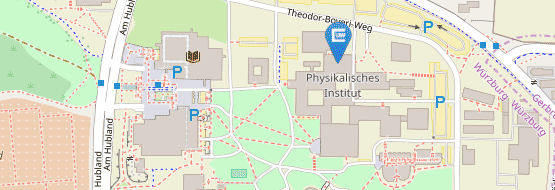Würzburg ToCoTronics Colloquium
"Exploring Electron Correlation Effects at Adsorbate-Metal Interfaces"
| Datum: | 20.02.2025, 16:15 - 18:00 Uhr |
| Kategorie: | Kolloquium |
| Ort: | Hubland Süd, Geb. P1 (Physik), HSP P (Röntgen HS) |
| Veranstalter: | SFB 1170 ToCoTronics |
| Vortragende: | Dr. David Janas - TU Dortmund |
The role of many-body effects at adsorbate-metal interfaces is a crucial - but often overlooked - factor in designing materials for spintronic and catalytic applications. Recently, we could demonstrate that a chemisorbed layer of oxygen on a ferromagnetic iron (Fe) surface significantly enhances electron correlation, leading to spin-dependent broadening of adsorbate-related bands, narrowing of d-bands near the Fermi energy, and a reduced exchange splitting1. Interestingly, such changes in the exchange splitting are associated with enhanced catalytic activity2,3, suggesting that oxygen layers, traditionally considered as passivating, could instead boost surface reactivity in electro- and photocatalytic contexts.
Building on these insights, we investigate the interaction of a pentacene (5A) monolayer with the oxygen-passivated Fe surface using angle-resolved photoemission, scanning tunneling microscopy and spectroscopy. Our findings reveal unusual electronic fingerprints indicative of strong molecule-substrate interactions. To address the complexity of this system, we employ a Hubbard-corrected density functional theory (DFT+U) approach, guided by dynamical mean-field theory (DMFT) results, to approximate correlation effects. This unconventional approach, utilizing non-standard U values, successfully captures key phenomena of this interface without the computational cost of full DMFT, uncovering unexpectedly strong molecule-metal bonding.
Our results emphasize the importance of electron correlation in accurately reproducing experimental observations and reveal lateral inhomogeneities in the adsorbate-substrate interaction, arising from the large size and structural complexity of the organic adsorbate. By addressing these contributions, we propose an adapted framework for understanding and predicting the electronic properties and bonding characteristics of complex adsorbate-metal interfaces.
[1] Janas, D. M. et al. Adv. Mater. 35, 2205698 (2023).
[2] Cao, A. & Nørskov, J. K. ACS Catal. 13, 3456–3462 (2023).
[3] Zhang, K. et al. Science 383, 1357–1363 (2024).


